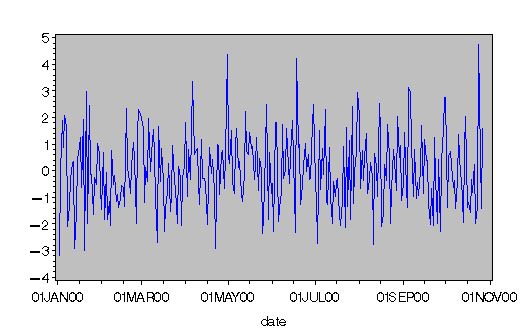| Time Series Analysis and Examples |
Getting Started
The fractional differencing enables the degree of differencing
![]() to take any real value rather than being restricted to integer
values. The fractionally differenced processes are capable of modeling
long-term persistence. The process
to take any real value rather than being restricted to integer
values. The fractionally differenced processes are capable of modeling
long-term persistence. The process
Consider an ARFIMA(![]() ) represented as
) represented as
![]() where
where ![]() .
With the following statements you can
.
With the following statements you can
- generate the simulated 300 observations data
- obtain the fractionally differenced data
- compute the autocovariance function
- compute the log-likelihood function
- fit a fractionally integrated time series model to the data
proc iml;
/* ARFIMA(0,0.4,0) */
lag = (0:12)`;
call farmacov(autocov_D_IS_04, 0.4);
call farmacov(D_IS_005, 0.05);
print lag autocov_D_IS_04 D_IS_005;
d = 0.4;
call farmasim(yt, d) n = 300 sigma = 2 seed=5345; print yt;
call fdif(zt, yt, d); print zt;
call farmalik(lnl, yt, d); print lnl;
call farmafit(d, ar, ma, sigma, yt); print d sigma;

|
Figure 10.34: Plot of Generated ARFIMA(0,0.4,0) Process (FARMASIM)
The FARMASIM function generates the data shown in Figure 10.34.

|
Figure 10.35: Plot of Fractionally Differenced Process (FDIF)
The FDIF function creates the fractionally differenced process.
Figure 10.35 shows a white noise series.
Figure 10.36: Autocovariance Functions of ARFIMA(0,0.4,0) and ARFIMA(0,0.05,0) Models (FARMACOV)
The first column is the autocovariance function of the ARFIMA(0,0.4,0)
model, and the second column is the autocovariance function
of the ARFIMA(0,0.05,0) model.
The first column decays to zero more slowly
than the second column.
|
Figure 10.37: Log-Likelihood Function of ARFIMA(0,0.4,0) Model (FARMALIK)
The first row value is the log-likelihood function of the
ARFIMA(0,0.4,0) model.
Since the default option of the estimates method is the
conditional sum of squares, the last two rows of Figure 10.37
do not have the values since the default estimation method is used.
|
Figure 10.38: Parameter Estimation of ARFIMA(0,0.4,0) Model (FARMAFIT)
The final estimates of the parameters are ![]() and
and ![]() ,
while the true values of the data generating process
are
,
while the true values of the data generating process
are ![]() and
and ![]() .
.
Copyright © 2009 by SAS Institute Inc., Cary, NC, USA. All rights reserved.